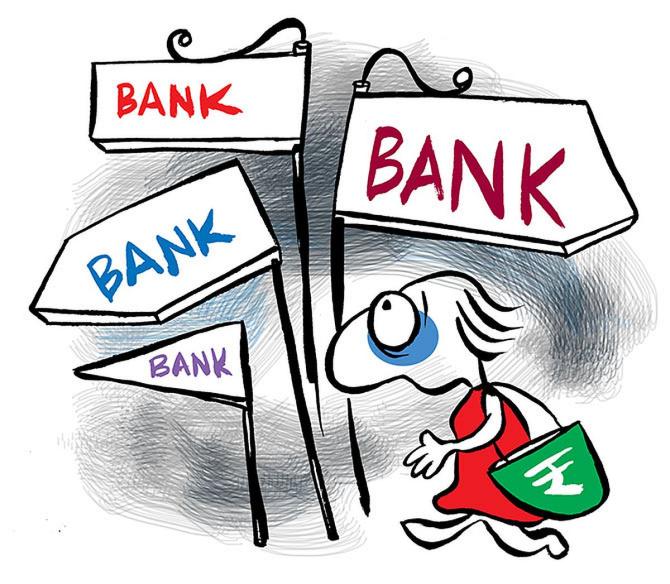Banks now ride on what is defined as a “banking outlet”.
This is a fixed-point service unit, manned by either the bank’s staff or its business correspondent (BC), where all kinds of services — acceptance of deposits, encashment of cheques, cash withdrawal or lending of money — are provided for a minimum of four hours per day, for at least five days a week.
Banks are now turning to reposition the manner in which they acquire customers, report Abhijit Lele and Raghu Mohan.
Did you know that 73 per cent of the 4,518 new branches that opened in FY19 (the latest year for which systemic data are available) are in urban, semi-urban or tier-3 cities?
This is higher than the 62.3 per cent seen in FY17, when the Reserve Bank of India (RBI) set its branch rationalisation policy in motion.
You may mistakenly interpret this to mean that banks are ignoring the hinterland.
Banks now ride on what is defined as a “banking outlet”.
This is a fixed-point service unit, manned by either the bank’s staff or its business correspondent (BC), where all kinds of services — acceptance of deposits, encashment of cheques, cash withdrawal or lending of money — are provided for a minimum of four hours per day, for at least five days a week.
The RBI’s new approach was transformative: it eased the pressure on banks to open branches.
Yet, this only partly explains the sharp fall in branches in tier-4 to tier-6 cities.
Explains C S Setty, State Bank of India’s managing director (retail and digital banking): “The number of unbanked areas where banks have viable operations is coming down.
“This is creating difficulties in opening branches in metropolitan and urban areas, since for every 100 branches, banks have to open 25 in unbanked areas.”
Basically, branches must first be opened in unbanked areas, and then the focus must shift to urban centres.
“It’s no more an issue of access to banking services, as the system has ensured the presence of outlets in every nook and corner of the country,” he adds.
What’s left unsaid is that a fresh look at branches is warranted.
In the yonder
The RBI’s Report on Trend and Progress of Banking in India (2018-19) observed branch concentration towards urban India — more of them were opened in high population-density areas for commercial viability, while relying on BCs to enhance outreach in other centres.
Now, what’s driving traffic into branches in urban areas, even as it is claimed that digital modes of payment have caught fire?
“A lot of business from non-banking financial companies moved into banks due to the shakeout in the sector, be it retail or wholesale.
“The millions of Pradhan Mantri Jan Dhan Yojana (PMJDY) accounts opened for the urban poor is also a factor; and then there is the gold-loan business which banks are now into in a big way,” points out Shyam Srinivasan, managing director and chief executive officer of Federal Bank.
PMJDY has led to increased footfall at bank branches in the more urbanised areas; and it will be some time before the bulk of the needs of such customers are serviced digitally.
This is because, while 77 per cent of the poorest 40 per cent in the country have an account with a financial institution (the highest among BRICS countries), their engagement with the financial system remains low.
This is reflected in the high proportion of inactive accounts, at close to 30 per cent.
It’s against this backdrop that the National Strategy for Financial Inclusion for India (2019-24) — prepared by the Financial Inclusion Advisory Committee — sought to renew the drive to make formal financial services accessible.
Little wonder that banks are now turning to reposition the manner in which they acquire customers.
Notes Navroze Dastur, managing director of NCR India, which now offers consultancy services to banks on this front, though it is into automated teller machines (ATMs): “A transaction can originate in one place and end in another.
“It can start at a store when you opt to buy white goods without an EMI, while you receive an EMI offer at an ATM — which you may opt for.”
He adds: “The nature of a bank as an outlet is undergoing a change.
“With digital growing in a big way, old ways of customer acquisition and servicing have also changed.
“And the branch strategy is reflecting this as well.”
It’s the key reason why foreign banks don’t clamour for more branches.
Says Kaushik Shaparia, chief country officer of Deutsche Bank (India): “While our 17 branches in 16 cities may seem like a small footprint for the business, the locations we are present in account for over 40 per cent of the country’s deposits and nearly 60 per cent of loans.”
The bank’s digital proposition, he adds, complements its branch presence; and while the surge in volumes on Deutsche Bank’s digital platforms is on the one hand an outcome of the pandemic, it is also a reflection of shifting customer preferences.
The bank branch is dead; long live the branch.
Source: Read Full Article


